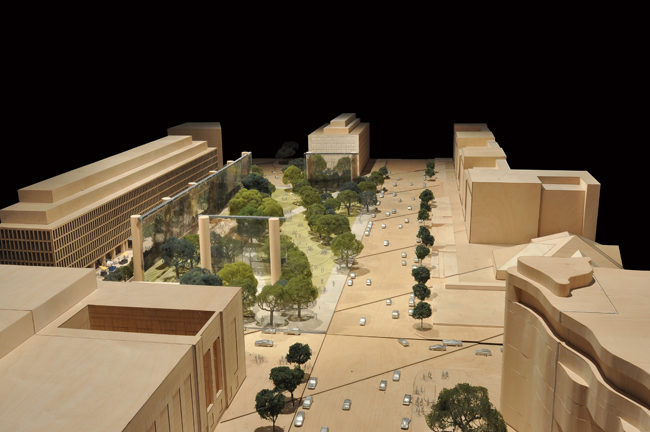Will the Frank Gehry-designed Ike Memorial ever get built?
| Image courtesy EMC |
|
The design features metal tapestries depicting Eisenhower’s childhood, along with stone bas-reliefs showing him as a general and president. Click to view more images. |
For an architect, no commission is more troublesome than creating a national memorial. Frank Gehry is learning firsthand just how fraught the process can be, with his design for a President Dwight D. Eisenhower memorial in Washington, D.C., generating widespread debate.
The mammoth project—it will stretch the length of a city block and be twice the size of the Lincoln Memorial—has drawn fire from an array of critics. Most notably, Eisenhower’s grandchildren complain the design fails to pay proper homage to the career of the World War II general and 34th U.S. president.
Gehry has proposed creating a park with several sculptural elements. Eighty-foot-high metal tapestries, with imagery depicting Eisenhower’s childhood in Kansas, would frame the 4-acre, open-air site. The interior features a low-lying stone wall inscribed with excerpts of speeches delivered by Eisenhower; a statute of him as a boy; and two stone bas-reliefs—one depicting him as a military hero, the other showing him as president. The memorial is slated to be built near the National Mall, across from the Smithsonian’s National Air and Space Museum.
“We’re losing a huge opportunity to tell the story of how Eisenhower served his country,” Susan Eisenhower, the president’s granddaughter, told Architectural Record. “You don’t earn a place in the memorial core of Washington based on your origins and your life’s journey. You’re there because the nation is grateful for your contribution. We don’t have Lincoln in a log cabin.”
Dissenters also argue that the design isn’t traditional enough. “The focus is Gehry, not Eisenhower,” says Justin Shubow, president of the National Civic Art Society, an organization that promotes classical design. “Gehry describes his work as representing chaos and danger. He has never done work representing someone else.”
So far, the 11-member Eisenhower Memorial Commission (EMC), which is overseeing the project, stands in full support of Gehry’s proposal. (Eisenhower’s grandson, David Eisenhower, sat on the commission until December 2011, when he stepped down). The olive branch the EMC has offered to opponents is that the Los Angeles–based architect hopes to meet with the Eisenhower family to address their concerns. Gehry declined to be interviewed for this story, although his firm did make public a letter the architect wrote to Congress stating that he would be willing to work with the family and modify the scheme.
The project is being condemned for reasons beyond design. Some complain that the EMC should have hosted an open competition rather than using the federal government’s standard approach to hiring an architect: The General Services Administration posts an online call for portfolios; a committee selects finalists who submit designs; the committee then chooses a winner. In the case of the Ike Memorial, Gehry beat out finalists Krueck + Sexton Architects, PWP Landscape Architecture, and Rogers Marvel Architects.
Defenders of the process say that an open competition wouldn’t draw top talent. “You’re basically saying to architects: ‘You’re skilled professionals and you’re going to go up against grade-school students,’” says Witold Rybczynski, an urbanism professor at the University of Pennsylvania. In March, he wrote an op-ed for the New York Times defending both the design and the selection process. Rybczynski sits on the U.S. Commission on Fine Arts, which ultimately must approve the memorial design.
Many hurdles await. Beyond getting the green light from the Arts Commission—which already approved the concept but still must approve elements such as statues and quotes—the design must go before the National Capital Planning Commission for preliminary and final approval. Moreover, money must be raised. Congress has agreed to pay for only half of the estimated $112 million project. As observers have noted, the Eisenhower family’s endorsement could be helpful, even necessary, when it comes to fundraising—and getting this memorial built.
This story appears in the May 2012 issue of Architectural Record.
Editor’s Note: This story was updated on April 19, 2012.








